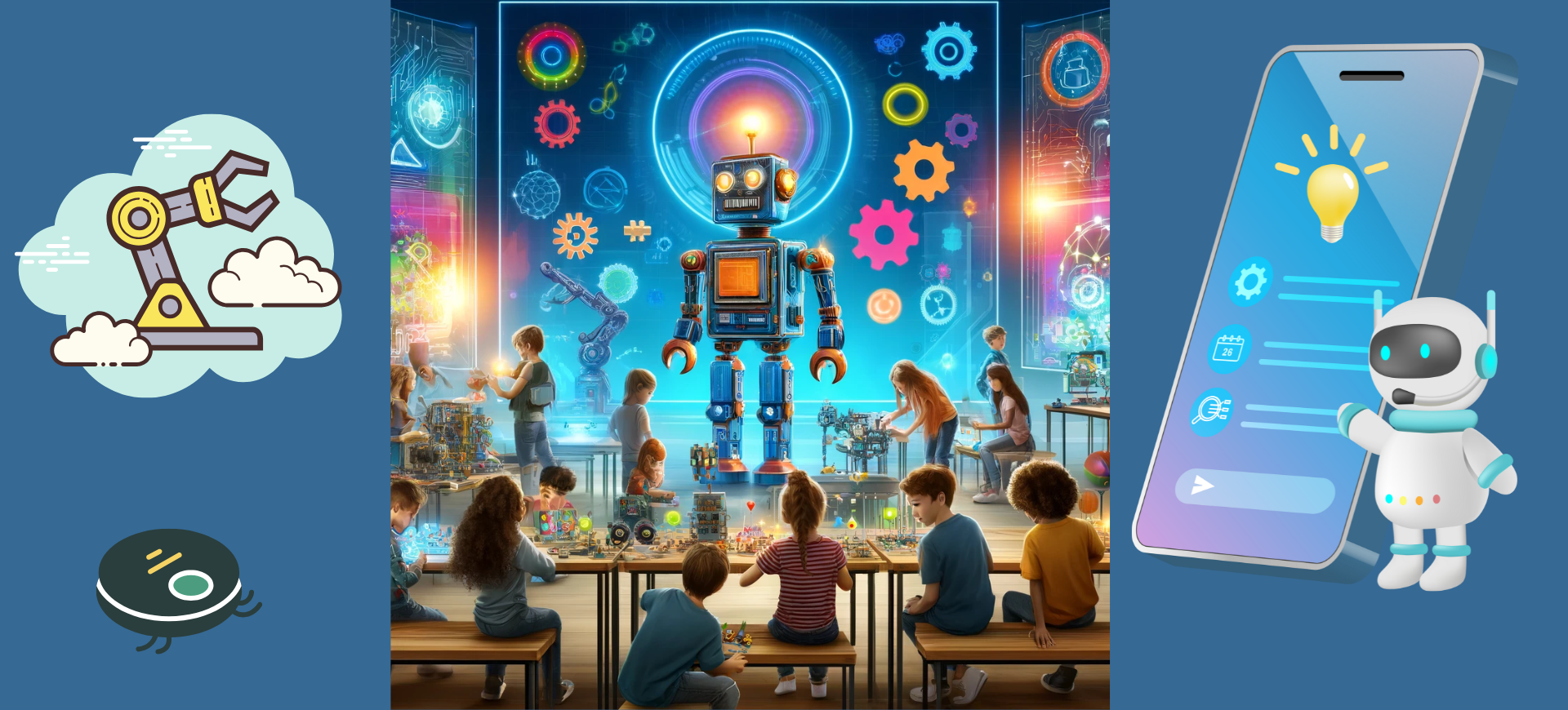Imagine your child not just using their favorite gadgets but understanding how they work—from the sensors in automatic doors to the coding behind video games. It’s more than magic; it’s Robotics and accessible even to young minds.
Introduction
Did you know that by 2030, 85% of jobs will require STEM skills, according to the National Science Foundation? [1] Robotics, a key component of STEM education, is more than just assembling parts or coding—it’s a gateway to developing essential life skills that go beyond technology. Imagine if your child used their favorite gadgets and understood how they work and could create their own.
One day, while we were driving, my daughter asked, “Why does the car seat belt alarm ring when I sit down?” Before I could answer, she figured it out: “There must be a switch that gets pressed when I sit on the seat.” This curiosity and problem-solving skill didn’t appear out of nowhere—it was sparked by her experience in Robotics classes.
If you’ve been wondering whether Robotics classes for kids are worth it, the answer is a resounding yes. Let’s explore the incredible, lifelong benefits of Robotics and why every child should have the chance to learn it.
1. Building Critical Thinking and Problem-Solving Skills
Learning Robotics isn’t just about putting parts together—it’s about diving into challenges and solving problems step by step. When kids take on projects like programming a robot to navigate a maze or create a sensor-based gadget, they develop critical thinking skills.
Here’s Why It Matters:
- Practical Learning: According to research by Stanford University [2], hands-on learning, like building robots, boosts problem-solving abilities by 40% compared to traditional methods.
- Everyday Problem Solving: Kids learn how to break down big problems into smaller, manageable pieces. Whether it’s figuring out why a toy stopped working or organizing their homework, these skills are invaluable.
Try This Challenge: Ask your child, “Why do automatic doors open when you walk toward them?” This simple question can lead to a fun discussion about sensors and how they work.
2. Promoting Creativity and Innovation
Robotics isn’t just about following a set of instructions—it’s a playground for creativity and innovation. Kids get to design, experiment, and bring their ideas to life. The possibilities are endless, from building a robot that dances to creating a gadget that solves a real-world problem. A study conducted by the Massachusetts Institute of Technology (MIT) found that students involved in Robotics programs show a 60% increase in creativity and innovative thinking [3].
Why Creativity in Robotics Is So Important:
- Encourages Original Ideas: Robotics coding for kids classes offer an open platform where they can experiment without fear of failure. This helps build a growth mindset and boosts their confidence.
- Combining Art and Tech: A SkoolOfCode student once created a robotic arm that drew intricate patterns in the sand, blending technology with mindfulness and art. While rooted in Robotics, this project showcased how creativity can flow when kids are allowed to think freely and innovatively. They don’t just build machines; they create experiences and bring new ideas to life.
Engage with Your Child: Ask them, “If you could invent a robot to help with something at home, what would it be?” This can lead to exciting conversations and spark creative thinking.
3. Gaining Technological Literacy for the Future
Did you know that by 2025, 90% of jobs will require some level of digital skills [4] (World Economic Forum)? Robotics introduces kids to the core concepts of technology, from basic coding to understanding circuits. These skills form the foundation for confidently navigating a tech-driven world.
Here’s How Robotics Prepares Kids for the Future:
- Coding and Robotics for Children: Learning to code through Robotics is an excellent way for kids to develop digital skills. They start with simple programming and gradually move on to complex projects, building confidence along the way.
- Technological Fluency: Kids learn the basics of how things work, which makes them more comfortable with new technologies like AI, automation, and smart devices.
Ask Yourself: Is your child ready to thrive in a world filled with smart homes, AI, and digital assistants? With Robotics education, they will be.
4. Developing Future Skills for Kids: Collaboration, Resilience, and Adaptability
Robotics projects often require teamwork, which helps children learn how to communicate their ideas effectively and work well with others. They also experience trial and error, teaching them to see failure as a learning opportunity rather than a setback. The World Economic Forum reports that by 2025, 90% of jobs will require some level of digital skills, making technological literacy essential for future careers [5].
Key Life Skills Your Child Will Gain:
- Collaboration: Working on group projects teaches kids how to share ideas, listen to others, and build solutions together.
- Resilience: In Robotics, not every project works perfectly the first time. Kids learn to troubleshoot and try again, building a strong mindset of resilience.
- Adaptability: As technology changes, so do the projects in Robotics classes. Kids learn to adapt quickly, a skill that will serve them in any future career.
Fun Activity: Ask your child to work with a friend or sibling to design a simple robot that can complete a household task. It’s a great way to practice collaboration and problem-solving together.
5. Preparing for Jobs of the Future
The U.S. Bureau of Labor Statistics projects that jobs in computer and information technology will grow by 15% from 2021 to 2031, outpacing the average growth rate across all occupation [6].
By learning Robotics, kids aren’t just gaining tech skills—they’re developing a mindset that will help them excel in any career they choose.
Careers Where Robotics Knowledge Can Shine:
- In Medicine: Surgeons use robotic-assisted tools for precise operations.
- In Business: Entrepreneurs use automation and Robotics to streamline processes and boost productivity.
- In the Arts: Digital artists use technology to create interactive installations and immersive experiences.
Did You Know? Jobs in computer and information technology are projected to grow by 15% from 2021 to 2031 (Bureau of Labor Statistics) [3]. By starting Robotics education early, your child will have a head start in understanding the tech-driven landscape of tomorrow.
A Vision for the Future:
Imagine your child as a future entrepreneur who uses Robotics knowledge to streamline business operations or as a digital artist creating immersive experiences. Whether they enter tech-heavy fields or choose non-tech careers, the problem-solving mindset and technical literacy gained from Robotics will help them thrive. Research from the Harvard Business Review indicates that entrepreneurs who leverage Robotics and automation report an increase in productivity by up to 20% [7].
Why Every Parent Should Support Robotics Education
As parents, we want to set our kids up for success in every possible way. Robotics education is one of the best investments you can make for your child’s future. It’s not just about building robots—it’s about building skills that last a lifetime. Here’s How SkoolOfCode Can Help:
At SkoolOfCode, we offer tailored Robotics classes for kids, guided by experienced teachers who make learning fun and engaging. Our programs help children develop critical thinking, creativity, and technological literacy—all essential future skills for kids.
Don’t wait to give your child the head start they deserve. Enroll them in a Robotics class today and watch their confidence and creativity soar.
- National Science Foundation. (2020). STEM Education for the Future – National Science Foundation. https://new.nsf.gov/edu
- The Impact of Experiential Learning on Problem-Solving Skills. Stanford Research, 2023, https://ed.stanford.edu/research.
- MIT Media Lab. “Creativity in STEM Education: The Role of Robotics.” MIT Study.
- World Economic Forum. “The Future of Jobs Report 2023.” WEF Future of Jobs Report, https://www.weforum.org/publications/the-future-of-jobs-report-2023/
- World Economic Forum. “The Future of Jobs Report 2023.” WEF Future of Jobs Report.
- U.S. Bureau of Labor Statistics. “Occupational Outlook Handbook: Computer and Information Technology Occupations.” BLS Report,
- Harvard Business Review. “The Impact of Robotics on Business Efficiency.” HBR Analysis.
By –Dr. Kadam Bhambari, an Educator at SkoolofCode with Ph.D. and MTech in Electronics. She is an expert in micro:bit, Arduino, and Artificial intelligence.

